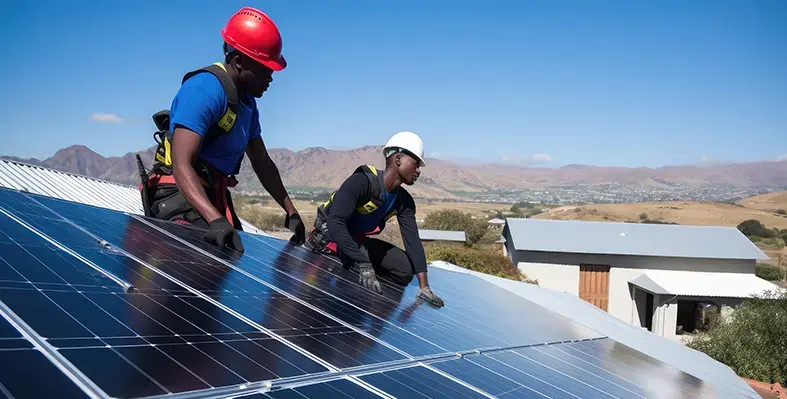Solar Photovoltaic (PV) systems have a significant role to play in increasing South Africa’s power generation capacity, explainsShaniel Lakhoo, a senior electronic engineer for WSP in Africa
However, the PV power generation profile used in recent long-term planning simulations does not accurately represent the current and expected future PV power generation in the country.
South Africa is at a critical juncture in its energy transition.
With Eskom predicting that solar PV’s contribution to generation capacity will grow to 19% by 2030, it is clear that solar energy will play a pivotal role.
Understanding the power production profile for PV plants is critical in ensuring the right decisions are made on the generation technology mix to best meet the nation’s electricity demand.
Deploying the right mix is also critical to provide a stable lowest-cost electricity solution for the country.
A key decision when it comes to utility-scale PV plant centres on how the modules are set up on the site and whether the modules are fixed in place and angled to compensate for the latitude (fixed-tilt) or track the sun during the day on a single horizonal axis (single-axis tracking).
The choice has significant implications for cost-effectiveness, energy output and ultimately influences when and how much power may be injected into the grid.
The importance of accurate PV power generation profiles
The accuracy of PV power generation profiles is crucial for long-term power generation capacity expansion planning. These profiles inform the broader energy mix and capacity planning for the future.
The country’s studies, included in the Integrated Resource Plan (IRP) 2019, show the predominant use of fixed-tilt systems, with the IRP 2023 not providing sufficient information to conclude the profile used. This is despite the growing use of single-axis trackers in real-world projects.
Single-axis trackers, which follow the sun’s path throughout the day, generally outperform fixed-tilt systems in terms of energy production.
In my research, I found energy gains of 12.9% to 20.1% could be achieved annually by using single-axis tracking systems as opposed to fixed-tilt systems. By analysing the Levelised Cost of Energy (LCOE) — a measure of the average net present cost of electricity generation for a plant over its lifetime — my research aimed to determine which configuration would offer the lowest LCOE.
Across all scenarios and locations, single-axis trackers consistently emerged as the most cost-effective solution. Despite the higher upfront costs, the energy gains from using trackers more than offset these expenses. This resulted in a lower LCOE compared to fixed-tilt systems.
Part of this research included a sensitivity analysis to understand the most significant factors impacting LCOE. The analysis revealed that the Balance Of System (BOS) costs and the Ground Coverage Ratio (GCR) are the most critical variables.
Interestingly, the cost of land had only a minor influence on LCOE. This was true even with the upper band equivalent to more than four times the profits that could be expected from using the land for agricultural purposes.
Bifacial modules were explored in my analysis as these become more prevalent in the market and are being deployed in new projects. However, my simulations found the additional energy produced by bifacial modules does not justify the 6% premium over single axis trackers. For fixed tilt systems, the added energy was sufficient to make this the lower LCOE solution.
These insights are crucial for decision-makers. The analysis showed that even in scenarios with lower GHI (Global Horizontal Irradiance), single-axis trackers with mono-facial modules remained the most cost-effective choice. Additionally, the plant design can be optimised based on GCR, knowing the cost of land is not a significant factor, thereby improving the overall feasibility of solar projects.
Creating a representative power profile
One of the valuable outcomes of the research was the development of a representative PV power generation profile for South Africa. This was achieved by weighting the contributions from the 11 Renewable Energy Development Zones (REDZ) across the country, against the expected deployment of PV according to the Integrated Resource Plan (IRP) 2019. The resultant profile blends these contributions to create a profile reflecting the anticipated future solar generation.
This new profile is based on the most cost-effective solution identified in simulations (single-axis trackers with mono-facial modules) and provides a revised profile that forms a more reliable basis for future energy planning. It is a step towards ensuring our long-term energy forecasts are grounded in the realities of the technologies we’re deploying.
The journey of exploring PV tracking choices has underscored the importance of aligning our energy planning with the latest technological and market advancements. As South Africa moves towards decarbonisation, it is crucial long-term planning reflects realistic predictions, rather than solely historical data or outdated assumptions.
The transition to renewable energy is not just about adopting innovative technologies. It comes down to making informed decisions that will shape the sustainability of our energy systems for decades to come.
In the case of utility-scale PV power plants, that means ensuring representative profiles are used when completing long-term planning simulations.
Shaniel Lakhoo is a senior electronic engineer for WSP in Africa
Read more:
SolarAfrica secures financial close for utility-scale SunCentral solar project in South Africa





